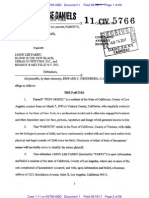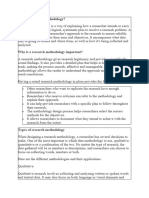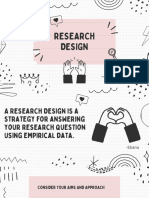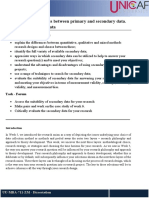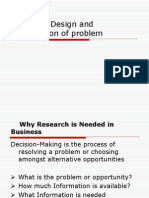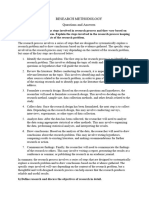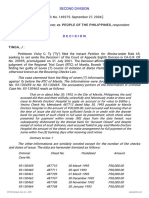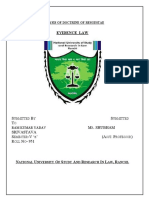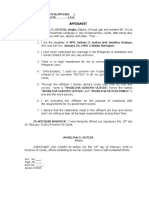Research Design – Types, Methods and Examples
Research Design
Definition:
Research design refers to the overall strategy or plan for conducting a research study. It outlines the methods and procedures that will be used to collect and analyze data, as well as the goals and objectives of the study. Research design is important because it guides the entire research process and ensures that the study is conducted in a systematic and rigorous manner.
Types of Research Design
Types of Research Design are as follows:
This type of research design is used to describe a phenomenon or situation. It involves collecting data through surveys, questionnaires, interviews, and observations. The aim of descriptive research is to provide an accurate and detailed portrayal of a particular group, event, or situation. It can be useful in identifying patterns, trends, and relationships in the data.
Correlational research design is used to determine if there is a relationship between two or more variables. This type of research design involves collecting data from participants and analyzing the relationship between the variables using statistical methods. The aim of correlational research is to identify the strength and direction of the relationship between the variables.
Experimental research design is used to investigate cause-and-effect relationships between variables. This type of research design involves manipulating one variable and measuring the effect on another variable. It usually involves randomly assigning participants to groups and manipulating an independent variable to determine its effect on a dependent variable. The aim of experimental research is to establish causality.
Quasi-experimental research design is similar to experimental research design, but it lacks one or more of the features of a true experiment. For example, there may not be random assignment to groups or a control group. This type of research design is used when it is not feasible or ethical to conduct a true experiment.
Case study research design is used to investigate a single case or a small number of cases in depth. It involves collecting data through various methods, such as interviews, observations, and document analysis. The aim of case study research is to provide an in-depth understanding of a particular case or situation.
Longitudinal Research Design
Longitudinal research design is used to study changes in a particular phenomenon over time. It involves collecting data at multiple time points and analyzing the changes that occur. The aim of longitudinal research is to provide insights into the development, growth, or decline of a particular phenomenon over time.
Structure of Research Design
The format of a research design typically includes the following sections:
Introducon
: This secton provides an overview of he research problem, he research questons, and he imporance of he sudy. I also includes a brief lieraure review ha summarizes previous research on he opic and identes gaps in he existng knowledge.

Research Quesons or Hypotheses:
This secton identes he specic research questons or hypoheses ha he sudy will address. These questons should be clear, specic, and esable.
Research Methods
: This secton describes he mehods ha will be used o collec and analyze daa. I includes deails abou he sudy design, he sampling sraegy, he daa collecton insrumens, and he daa analysis echniques.
Data Collecon:
This secton describes how he daa will be colleced, including he sample size,daa collecton procedures, and any ehical consideratons.
Data Analysis:
This secton describes how he daa will be analyzed, including he satstcal echniques ha will be used o es he research questons or hypoheses.
Results
: This secton presens he ndings of he sudy, including descriptve satstcs and satstcal ess.
Discussion and Conclusion
: This secton summarizes he key ndings of he sudy, inerpres heresuls, and discusses he implicatons of he ndings. I also includes recommendatons for fuure research.
References
: This secton liss he sources cied in he research design.
Example of Research Design
An Example of Research Design could be:
Research question:
Does the use of social media affect the academic performance of high school students?
Research design:
The research approach will be quantatve as i involves collectng numerical daa o es he hypohesis.
Research design
: The research design will be a quasi-experimenal design, wih a prees-poses conrol group design.
: The sample will be 200 high school sudens from wo schools, wih 100 sudens in heexperimenal group and 100 sudens in he conrol group.
: The daa will be colleced hrough surveys adminisered o he sudens a he beginning and end of he academic year. The surveys will include questons abou heir social media usage and academic performance.
: The daa colleced will be analyzed using satstcal soware. The mean scores of he experimenal and conrol groups will be compared o deermine wheher here is a signican dierence in academic performance beween he wo groups.
Limitaons
: The limiatons of he sudy will be acknowledged, including he fac ha social media usage can vary grealy among individuals, and he sudy only focuses on wo schools, which may no be represenatve of he entre populaton.
Ethical consideraons:
Ehical consideratons will be aken ino accoun, such as obaining informed consen from he partcipans and ensuring heir anonymiy and condentaliy.
How to Write Research Design
Writing a research design involves planning and outlining the methodology and approach that will be used to answer a research question or hypothesis. Here are some steps to help you write a research design:
Dene the research queson or hypothesis
: Before beginning your research design, you should clearly dene your research queston or hypohesis. This will guide your research design and help you selec appropriae mehods.
Select a research design:
There are many dieren research designs o choose from, including experimenal, survey, case sudy, and qualiatve designs. Choose a design ha bes s your research queston and objectves.
Develop a sampling plan
: If your research involves collectng daa from a sample, you will need o develop a sampling plan. This should ouline how you will selec partcipans and how many partcipans you will include.
Dene variables:
Clearly dene he variables you will be measuring or manipulatng in your sudy. This will help ensure ha your resuls are meaningful and relevan o your research queston.
Choose data collecon methods
: Decide on he daa collecton mehods you will use o gaher informaton. This may include surveys, inerviews, observatons, experimens, or secondary daasources.
Create a data analysis plan:
Develop a plan for analyzing your daa, including he satstcal or qualiatve echniques you will use.
Consider ethical concerns
: Finally, be sure o consider any ehical concerns relaed o your research, such as partcipan condentaliy or poental harm.
When to Write Research Design
Research design should be written before conducting any research study. It is an important planning phase thatoutlines the research methodology, data collection methods, and data analysis techniques that will be used to investigate a research question or problem. The research design helps to ensure that the research is conducted in a systematic and logical manner, and that the data collected is relevant and reliable.Ideally, the research design should be developed as early as possible in the research process, before any data iscollected. This allows the researcher to carefully consider the research question, identify the most appropriate research methodology, and plan the data collection and analysis procedures in advance. By doing so, the research can be conducted in a more efficient and effective manner, and the results are more likely to be valid and reliable.
Purpose of Research Design
The purpose of research design is to plan and structure a research study in a way that enables the researcher to achieve the desired research goals with accuracy, validity, and reliability. Research design is the blueprint or the framework for conducting a study that outlines the methods, procedures, techniques, and tools for data collection and analysis.Some of the key purposes of research design include:
Providing a clear and concise plan of acton for he research sudy.
Ensuring ha he research is conduced ehically and wih rigor.
Maximizing he accuracy and reliabiliy of he research ndings.
Minimizing he possibiliy of errors, biases, or confounding variables.
Ensuring ha he research is feasible, practcal, and cos-eectve.
Deermining he appropriae research mehodology o answer he research queston(s).
Identfying he sample size, sampling mehod, and daa collecton echniques.
Deermining he daa analysis mehod and satstcal ess o be used.
Faciliatng he replicaton of he sudy by oher researchers.
Enhancing he validiy and generalizabiliy of he research ndings.
Applications of Research Design
There are numerous applications of research design in various fields, some of which are:
Social sciences:
In elds such as psychology, sociology, and anhropology, research design is used o investgae human behavior and social phenomena. Researchers use various research
designs, such as experimenal, quasi-experimenal, and correlatonal designs, o sudy dieren aspecs of social behavior.
Educaon
: Research design is essental in he eld of educaton o investgae he eectveness of dieren eaching mehods and learning sraegies. Researchers use various designs such as experimenal, quasi-experimenal, and case sudy designs o undersand how sudens learn and how o improve eaching practces.
Health sciences
: In he healh sciences, research design is used o investgae he causes, preventon, and reamen of diseases. Researchers use various designs, such as randomized conrolled rials, cohor sudies, and case-conrol sudies, o sudy dieren aspecs of healh and healhcare.
Business
: Research design is used in he eld of business o investgae consumer behavior, marketng sraegies, and he impac of dieren business practces. Researchers use various designs, such as survey research, experimenal research, and case sudies, o sudy dieren aspecs of he business world.
Engineering
: In he eld of engineering, research design is used o investgae he developmen and implemenaton of new echnologies. Researchers use various designs, such as experimenal research and case sudies, o sudy he eectveness of new echnologies and o identfy areas for improvemen.
Advantages of Research Design
Here are some advantages of research design:
Systemac and organized approach
: A well-designed research plan ensures ha he research is conduced in a sysematc and organized manner, which makes i easier o manage and analyze he daa.
Clear objecves:
The research design helps o clarify he objectves of he sudy, which makes i easier o identfy he variables ha need o be measured, and he mehods ha need o be used o collec and analyze daa.
Minimizes bias:
A well-designed research plan minimizes he chances of bias, by ensuring ha he daa is colleced and analyzed objectvely, and ha he resuls are no inuenced by he researcher’s personal biases or preferences.
Ecient use of resources:
A well-designed research plan helps o ensure ha he resources (tme, money, and personnel) are used ecienly and eectvely, by focusing on he mos imporan variables and mehods.
Replicability:
A well-designed research plan makes i easier for oher researchers o replicae he sudy, which enhances he credibiliy and reliabiliy of he ndings.
Validity:
A well-designed research plan helps o ensure ha he ndings are valid, by ensuring ha he mehods used o collec and analyze daa are appropriae for he research queston.
Generalizability
: A well-designed research plan helps o ensure ha he ndings can be generalized o oher populatons, sengs, or siuatons, which increases he exernal validiy of he sudy.
Research Design Vs Research Methodology
Research DesignResearch Methodology
The plan and srucure for conductng research ha oulines heThe se of principles, echniques, and ools used o carry


